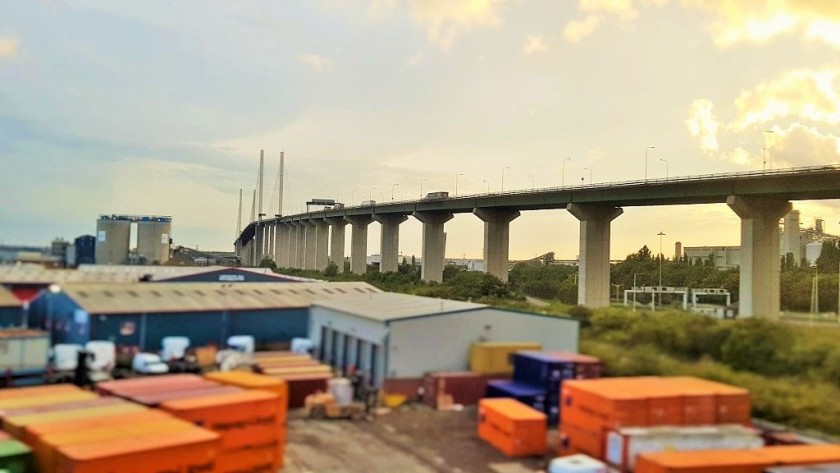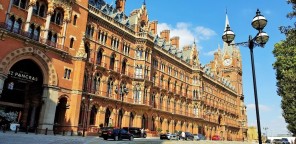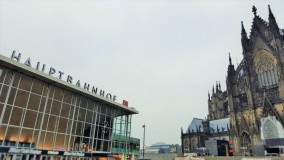Related Content
Content

München / Munich to London by train
How to take a thrilling high speed rail journey from Munich/München to London
There are two optimum route options for a journey by train from Munich/München to London:
-
Make two transfers between trains and travel via Bruxelles, thereby avoiding having to make a transfer between stations in Paris.
On this routing the optimum end=to-end journey involves having to make the connection between trains in Koin/Cologne. -
Travelling via Paris (not available on Saturdays) on the direct train from München to the Gare de l'Est, then heading to the Gare du Nord in order to take the Eurostar on to London.
What currently isn't an option is taking the overnight train from München to Bruxelles and then on by Eurostar, as that train to the Belgian capital isn't operating at the moment.
Share
Routes
Option 1: travelling via Paris
Journey Summary
10hr 53min (Mon to Fri); 11hr 16min (Sundays)
currently not available on Saturday
Travel Information
Travelling on Monday - Friday:
The only direct train of the day from München to Paris typically departs at 06:46.
The current schedule allows around 2hr 30mins to to make the transfer between the stations in Paris and check-in for the Eurostar.
So making the connection into the Eurostar train on to London is virtually guaranteed.
In the very unlikely scenario of missing the booked connection due to the late arrival of the train from Munchen/Munich, tickets can be transferred free of charge to a subsequent departure at the Eurostar ticket desk in the Gare Du Nord.
Be wary of booking end-to-end journeys via Paris which involve making an additional connection in Stuttgart as the combinations of trains can involve making tightly timed connections which won't be guaranteed.
Travelling on Sunday:
The only direct train of the day from München to Paris typically departs at 06:23; and as the train departs around 20 mins earlier than on a Monday to Friday, this allows the transfer time in Paris to be around 2hr 50min.
Time enough for a late lunch in a brasserie by the Gare du Nord if everything is the train arrives in Paris at the scheduled time.
1 x connection per day
Change trains in: Paris
Tickets
Book Early And Save: Yes
Online bookings open: Around 120 days ahead of the travel date (usually)
Look for the journey option that departs Munchen/Munich at 06:23 (Sunday); 06:56 (Mon-Fri)
As this routing always allows a minimum of two hours in Paris, an option is use the left luggage offices at the Gare De l'Est or Gare Du Nord and take the time to see something of the French capital between trains.
Although this routing via Paris tends to more expensive than the alternative route via Bruxelles/Brussels.
Where to book
| Ticket Provider | Approximate Cost | |
|---|---|---|
| Trainline | from €95 approx |
Train 1
Travelling On
Journey Features
This is a journey of five distinct parts;
1: Between Munchen and Stuttgart there are pleasant views, particularly from the left of the train after departure from Ulm.
2: Between Stuttgart and Karlsruhe, the train will spend around 20 mins on the high speed line, between the tunnels the railway crosses spectacular viaducts and the image at the top of the page was taken from one of these.
3. South of Karlsruhe the train initially travels on another high speed line, until it has passed Baden Baden.
4. The train then leaves the high speed line and makes it way, fairly slowly, towards the border with France, see if you can spot when you have left Germany behind, it won't be announced on the train.
5: Between Strasbourg and Paris, the train travels at up to 300 km/h on the fastest high speed line in France.
The train will reverse direction on departure from Stuttgart.
Train 2
Travelling On
Journey Features
Good to Know
Final Destination: London St Pancras
Some trains also call at: Ashford International or Ebbsfleet International (these station calls are currently suspended_
Note that London is in a different time zone to mainland Europe, it is one hour behind, so when looking at a timetable the journey will look as though it's an hour shorter.
Checking-in:
Eurostar requests that holders of Standard Class And Standard Premier tickets check-in a minimum of 30mins before departure, and 45mins before departure on weekends and holidays.
It is up to you to allow time to pass through check-in and board the train.
If you have a Business Premier ticket, Eurostar recommends that you only have to check-in 10 mins before departure.
At Gare Du Nord the check in and waiting area for the Eurostar (the 'Hall Du Londres') is at an upper level, above the main concourse.
The access to this upper level is some distance from the voie/platforms/tracks that the Eurostars depart from.
The escalators leading up to Eurostar departures are located at the rear wall of the station building, on the opposite side of the concourse to voies/platforms/tracks 14 - 15.



It's not a scenic journey, but it is a journey with distinct phases and highlights:
1: There is little to see from the high speed lines in France, particularly after Lille (the trains to Paris will rush through Lille Europe station).
2: The train will slow down as it approaches The Channel Tunnel.
Announcements are no longer made that the train is about to enter the tunnel.
The journey through the tunnel will take around 22 mins.
3: As the train nears Ebbsfleet International station, comes the scenic highlight of the journey - the crossing of the River Medway on a high bridge.
4: After Ebbsfleet International (which can only be seen from the right) the train will enter a tunnel under the River Thames.
As the train exits this tunnel, from the left, the Queen Elizabeth II road bridge can be seen.
5: For most of the final 8 -10 mins of the journey the trains use tunnels to enter London (Stratford International station is located between the tunnels).


Option 2: travelling via Bruxelles
Journey Summary
from 10hr 30min (approx)
Daily
Travel Information
Take care when looking up this journey as when departing from München at 07:28 daily, the connecting time in Koln Hbf between the arrival of the ICE train from Munchen and the Thalys train on to Bruxelles, will be around 35-40 mins.
Pretty much ideal if the train arrives on time, however, making this connection is not guaranteed!
It is not particularly unusual for the ICE trains from Munchen/Munich to arrive more than 30 minutes late into Koln hbf.
If need be tickets can be transferred free of charge to later departures, but it's a scenario that's best avoided.
Hence our preference for making this journey would be to travel via Paris, as the end-to-end journey times allow for what should be a pretty much guaranteed connection in the French capital.
Though on Sunday an option is to depart Munchen at 06:44 on an end-to-end routing, which allows more than 80 minutes to make the connection in Koln/Cologne, though you will need to transfer between Koln Messe/Deutz stationand Koln hbf.
Mon - Sat = 1 x connection per day
Sunday = 2 x connections
Change trains in: Koln and Bruxelles/Brussels
Tickets
Book Early And Save: Yes
Online bookings open: usually open around 6 months ahead of the travel date.
When looking up this journey target the trains which depart at 07:28 daily and at 06:44 on Sundays.
There will be other journey options available, but look out for tightly timed connections between trains of under 30mins, as they are definitely best avoided on this route.
Where to book
| Ticket Provider | Approximate Cost | |
|---|---|---|
| DB | * | |
| Trainline | from €69.90 |
Train 1
Travelling On
Journey Features
Good to Know
Final Destination: Essen
The train also calls at: Munchen-Passing and Augsburg; Ulm and Stuttgart
This is a journey of six distinct phases
- Until Stuttgart the train will travel on a conventional railway and the most scenic part of this journey occurs to the north of Ulm, when the railway threads through some narrow valleys.
- The train will reverse direction on departure from Stuttgart and head on to the high speed line.
- For around 25 minutes the train will travel at more than 250 km/h until the outskirts of Mannheim.
- Between Mannheim and Frankfurt Flughafen the railway travels through a string of commuter towns.
- On departure from Frankfurt Flughafen comes the part of the journey with a wow factor, when the train spends around 40 minutes racing along the rollercoaster that is the high speed line to Siegburg/Bonn, at more than 280 km/h.
- After Siegburg/Bonn the final part of the journey is on a conventional railway.
Train 2
Travelling On
Journey Features
Good to Know
Final Destination: Paris - Nord



For virtually the entire train journey from Koln to Bruxelles the trains, will either be travelling at up to 290 km/h on purpose built high speed lines, or up to 200km/h on section of railway, that has been re-engineered to allow trains to travel faster.
It is a journey of six distinct phases:
- Between Koln and Aachen the trains travel at up to 200 km/h on a re-engineered stretch of railway.
- Then for most of the the 25 min journey between Aachen and Liege the train will travel at up to 290 km/h on a high speed line; this is also the most scenic part of the trip.
- Then for around five minutes after departure from Liege, the train will travel fairly slowly on a route which ascends from the city.
- Next up is the HS2 Belgian high speed route as far as Leuven, in theory the ICE and Thalys trains can accelerate back up to around 290 km/h on this part of the trip.
- From Leuven to just north of Brussel-Nord station the maximum speed is 200 km/h.
- For most of the journey between Brussel-Nord and Brussel-Zuid the railway crosses the city centre in a tunnel.
Train 3
Travelling On
Journey Features
Good to Know
As a consequence of the Covid-19 crisis Eurostar is operating a particularly limited timetable for the time being - further information is available on Eurostar.com
Final Destination: London St. Pancras International
Some trains* also call at : Ebbsfleet International; Ashford International (these station calls are suspended for the time being)
Note that London is in a different time zone to mainland Europe, it is one hour behind - so when looking at a timetable the journey will look as though it's an hour shorter.
Most of the departures between Bruxelles/Brussels and London will be by the e320 trains; but the e300 trains are also used on this route.
Our guide to taking the Eurostar from Bruxelles/Brussels has more information including details of check-in and how to connect into the Eurostar from other train services.
Our guide to arriving by Eurostar in London is here.



It's not a scenic journey, but it is a journey with distinct phases and highlights:
1: There is little to see from the high speed lines in Belgium and France.
2: The train will slow down as it approaches The Channel Tunnel.
Announcements are no longer made that the train is about to enter the tunnel.
The journey through the tunnel will take around 22 mins.
3: As the train nears Ebbsfleet International station, comes the scenic highlight of the journey - the crossing of the River Medway on a high bridge.
4: After Ebbsfleet International (which can only be seen from the right) the train will enter a tunnel under the River Thames.
As the train exits this tunnel, from the left, the Queen Elizabeth II road bridge can be seen.
5: For most of the final 8 -10 mins of the journey the trains use tunnels to enter London (Stratford International station is located between the tunnels).


Newsletter
Sign up to receive the latest travel news stories and to hear about what we've been working on for you.
See if there’s a unique journey guide for your trip, featuring info on the trains, tickets & stations.

This is one of more than 1000 journey guides available on ShowMeTheJourney, which will make it easier to take the train journeys you want or need to make. As always, all images were captured on trips taken by ShowMeTheJourney.
























